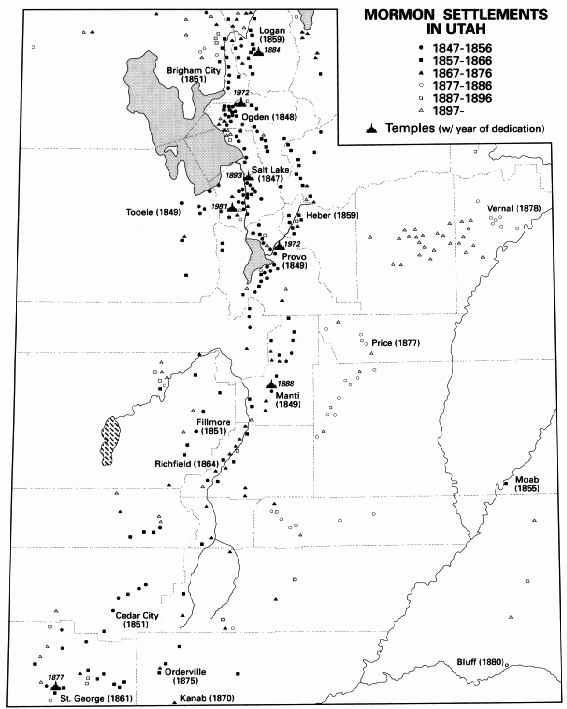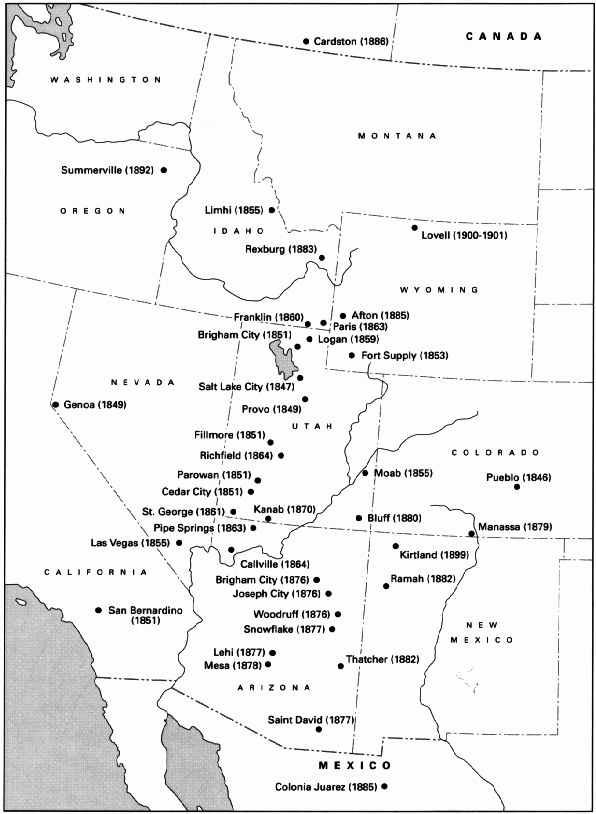
Colonization |

This view of Logan, Utah, c. 1890, with the Logan Temple above the town and grist mill in the foreground, shows the broad streets and typical layout of a thriving "Mormon village." Courtesy University of Utah.
by Richard L. Jensen
Latter-day Saints were industrious colonizers of the American West. During the Brigham Young administration alone, they founded nearly four hundred settlements, with three hundred more thereafter. Though some were distant from Salt Lake City, they were not isolated villages but maintained close communication with adjacent settlements and Church headquarters. Following a pattern that emerged in the Church's first decade, each was founded to provide protection and promote unity and shared values.
Between 1830 and 1846, Latter-day Saints settled in or near a series of Church headquarters. After conflict and persecution in New York, Ohio, Missouri, and Illinois, they sought refuge in a virtual no-man's-land in the West. After establishing a new headquarters in the heretofore largely uninhabited Salt Lake Valley, Latter-day Saints sought to ensure self-rule by establishing a dominant influence over a vast territory including present-day Utah and Nevada and parts of Idaho, Wyoming, and California. Immigrant converts, first from the United States and the British Isles and after 1852 from continental Europe, swelled the ranks of colonists. Under the direction of President Brigham Young, exploring parties were sent out and settlements were established in a corridor extending from the Salt Lake Valley southwest to Las Vegas, Nevada, and San Bernardino, California. Missions to Native Americans prompted the establishment of several settlements around the perimeter of the Mormon sphere of influence: Fort Limhi, Idaho, on the Salmon River to the northwest; the Elk Mountain Mission to the southeast (near present-day Moab, Utah); and Harmony and Santa Clara, Utah, and Las Vegas to the southwest. Settlements in Carson Valley, Nevada, on the west were an outgrowth of individual LDS enterprise along the route of gold-seekers traveling to California, reinforced at the direction of Church leaders. To the northeast, Fort Bridger and Fort Supply, Wyoming, were to anchor a series of way stations between Salt Lake City and the Missouri River along the Mormon Trail to facilitate immigration and trade. San Bernardino was to be a temporary gathering place for Saints from the Pacific Coast.
For various reasons, most of these outer colonies proved less than successful and were discontinued by 1858. The March of the Utah expedition toward Utah and hostility provoked by the Mountain Meadows Massacre prompted a withdrawal from most distant outposts. After the conclusion of the so-called Utah War, colonization resumed, but within a more compact territory. St. George, Utah, the focal point of the 1861 Cotton Mission, became a key settlement in the Southwest. With President Young's persistent support, that settlement survived the demise of its cotton industry after America's Civil War and the abandonment of LDS efforts to establish a route for trade and immigration via the Gulf of California and the lower Colorado River. With the addition of settlements in northern Utah and southern Idaho, the population came to be most heavily concentrated in the territory's northern region.
Meanwhile, the extension of settlement beyond the Salt Lake Valley deprived Native Americans of prime hunting and fishing lands. After initial conflicts, President Young established a policy of feeding the Indians rather than fighting them, but still advised villages to build fortifications against possible attack. Latter-day Saints sought to convert the Indians both to their religion and to the pursuit of agriculture. Even with the assistance of federally sponsored farms, however, few Indians made successful transitions. The continued influx of LDS immigrants and the failure of Church and government efforts to reverse the gradual impoverishment of the Native American population led to the Walker War of the 1850s and to the Black Hawk War of the 1860s. The subsequent resettlement of the surviving Indians to reservations removed one of the major obstacles to further colonization.
Before Brigham Young's death in 1877, additional settlements were planted along the Little Colorado River in Arizona, followed by more in Colorado, New Mexico, Canada, and Mexico. Elsewhere, the Palawai Valley on the island of Lanai and, later, Laie on Oahu became gathering places for Saints in Hawaii, the first such settlements outside western North America.
Colonization was generally directed and coordinated from Church headquarters. Church leaders selected key sites and hand-picked leaders to direct the founding of new villages. Some settlers volunteered, while others received a calling to relocate. When LDS families established new locations on their own initiative, Church leaders usually visited soon afterward to ensure that the settlement was properly organized. Thus, each settlement was effectively a colony of the mother settlement in Salt Lake City. From initial sites, Latter-day Saints spread out to occupy most of the arable land nearby and founded new towns.
Beginning in 1880, Mormon villages spread along the route of the Utah and Northern Railway and the Upper Snake River Valley in Idaho. Many of these were settled through individual initiative rather than Church direction, and Church leaders labored with some difficulty to encourage the location of homes in the customary compact Mormon villages rather than scattered throughout the surrounding farmland.
Colonies in Alberta, Canada, and in Chihuahua, Mexico, largely resulted from the Church's attempts to find refuge for polygamists under threat of prosecution during the 1880s (see Antipolygamy Legislation). Later efforts included the Big Horn Basin of Wyoming by 1900 and Kelsey, Texas, in 1901. Though Kelsey was one of only a handful of LDS settlements established outside the larger sphere of Latter-day Saint influence, the town still exhibited many of the characteristics of a planned Mormon village.
Early in the twentieth century, new colonization ceased and emphasis was placed on strengthening congregations throughout the world rather than on gathering to already predominantly LDS communities.
(See Basic Beliefs home page; Church Organization and Priesthood Authority home page; The Worldwide Church home page; Gathering and Colonization home page)
Illustrations

Mormon settlements in Utah, 1847-1906.

Selected Mormon settlements in the West, 1847-1890.
Bibliography
Arrington, Leonard J. Great Basin Kingdom. Cambridge, Mass., 1958.
Campbell, Eugene E. "Brigham Young's Outer Cordon—A Reappraisal." Utah Historical Quarterly 41 (Summer 1973):220-53.
Hunter, Milton R. Brigham Young the Colonizer. Santa Barbara, Calif., 1973.
Sherlock, Richard. "Mormon Migration and Settlement After 1875." Journal of Mormon History 2 (1975):53-68.
Encyclopedia of Mormonism, Vol. 1, Colonization
Copyright © 1992 by Macmillan Publishing Company
All About Mormons |